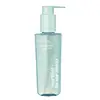What's inside
What's inside
 Key Ingredients
Key Ingredients

No key ingredients
 Benefits
Benefits

 Concerns
Concerns

No concerns
 Ingredients Side-by-side
Ingredients Side-by-side

Water
Skin ConditioningGlycerin
HumectantCocamidopropyl Betaine
CleansingPropanediol
SolventHydroxypropyl Bis-Hydroxyethyldimonium Chloride
HumectantSodium Methyl Cocoyl Taurate
CleansingSodium Benzoate
MaskingPanthenol
Skin ConditioningTrehalose
HumectantAcrylates/C10-30 Alkyl Acrylate Crosspolymer
Emulsion StabilisingXanthan Gum
EmulsifyingSodium Chloride
MaskingSaccharide Isomerate
HumectantAllantoin
Skin ConditioningPolyquaternium-39
Chlorphenesin
AntimicrobialGlyceryl Polyacrylate
Potassium Hydroxide
BufferingDisodium EDTA
Butylene Glycol
HumectantBetaine
HumectantSodium PCA
HumectantCitric Acid
BufferingSodium Citrate
BufferingSodium Lactate
BufferingPCA
HumectantHouttuynia Cordata Extract
Skin ConditioningSerine
MaskingAlanine
MaskingGlycine
BufferingGlutamic Acid
HumectantLysine Hcl
Skin ConditioningThreonine
Arginine
MaskingPentylene Glycol
Skin ConditioningBeta-Glucan
Skin ConditioningCaprylyl Glycol
EmollientProline
Skin ConditioningWater, Glycerin, Cocamidopropyl Betaine, Propanediol, Hydroxypropyl Bis-Hydroxyethyldimonium Chloride, Sodium Methyl Cocoyl Taurate, Sodium Benzoate, Panthenol, Trehalose, Acrylates/C10-30 Alkyl Acrylate Crosspolymer, Xanthan Gum, Sodium Chloride, Saccharide Isomerate, Allantoin, Polyquaternium-39, Chlorphenesin, Glyceryl Polyacrylate, Potassium Hydroxide, Disodium EDTA, Butylene Glycol, Betaine, Sodium PCA, Citric Acid, Sodium Citrate, Sodium Lactate, PCA, Houttuynia Cordata Extract, Serine, Alanine, Glycine, Glutamic Acid, Lysine Hcl, Threonine, Arginine, Pentylene Glycol, Beta-Glucan, Caprylyl Glycol, Proline
 Reviews
Reviews

Ingredients Explained
These ingredients are found in both products.
Ingredients higher up in an ingredient list are typically present in a larger amount.
Allantoin is a soothing ingredient known for its protective and moisturizingg properties. Because of this, it is often added to products with strong active ingredients.
Studies show higher concentrations of this ingredient can promote wound healing.
Though it can be derived from the comfrey plant, allantoin is produced synthetically for cosmetic products to ensure purity.
Learn more about AllantoinArginine is an amino acid that is important for human development. Your body uses is it to produce hair keratin and skin collagen.
As a cosmetic ingredient, Arginine has antioxidant properties and can also help repair damaged skin. This ingredient is derived either synthetically or from animals.
Arginine isn't fungal acne safe when used in the presence of other lipids (fats, fatty acids, oils, esters, etc). Oils and fats occur naturally within the skin, so take caution when using Arginine if you're prone to fungal acne.
Learn more about ArginineBetaine is a common humectant (a substance that promotes retention of moisture). It's known to be gentle on the skin and can help balance hydration.
This ingredient is best for improving hydration and soothing irritated skin. Studies also show it helps even out skin tone.
Fun fact: Betaine is naturally created in the skin and body. The kind found within cosmetic products can be either plant-derived or synthetic.
Another name for betaine is trimethylglycine.
Learn more about BetaineButylene Glycol (or BG) is used within cosmetic products for a few different reasons:
Overall, Butylene Glycol is a safe and well-rounded ingredient that works well with other ingredients.
Though this ingredient works well with most skin types, some people with sensitive skin may experience a reaction such as allergic rashes, closed comedones, or itchiness.
Learn more about Butylene GlycolPanthenol is a common ingredient that helps hydrate and soothe the skin. It is found naturally in our skin and hair.
There are two forms of panthenol: D and L.
D-panthenol is also known as dexpanthenol. Most cosmetics use dexpanthenol or a mixture of D and L-panthenol.
Panthenol is famous due to its ability to go deeper into the skin's layers. Using this ingredient has numerous pros (and no cons):
Like hyaluronic acid, panthenol is a humectant. Humectants are able to bind and hold large amounts of water to keep skin hydrated.
This ingredient works well for wound healing. It works by increasing tissue in the wound and helps close open wounds.
Once oxidized, panthenol converts to pantothenic acid. Panthothenic acid is found in all living cells.
This ingredient is also referred to as pro-vitamin B5.
Learn more about Panthenol